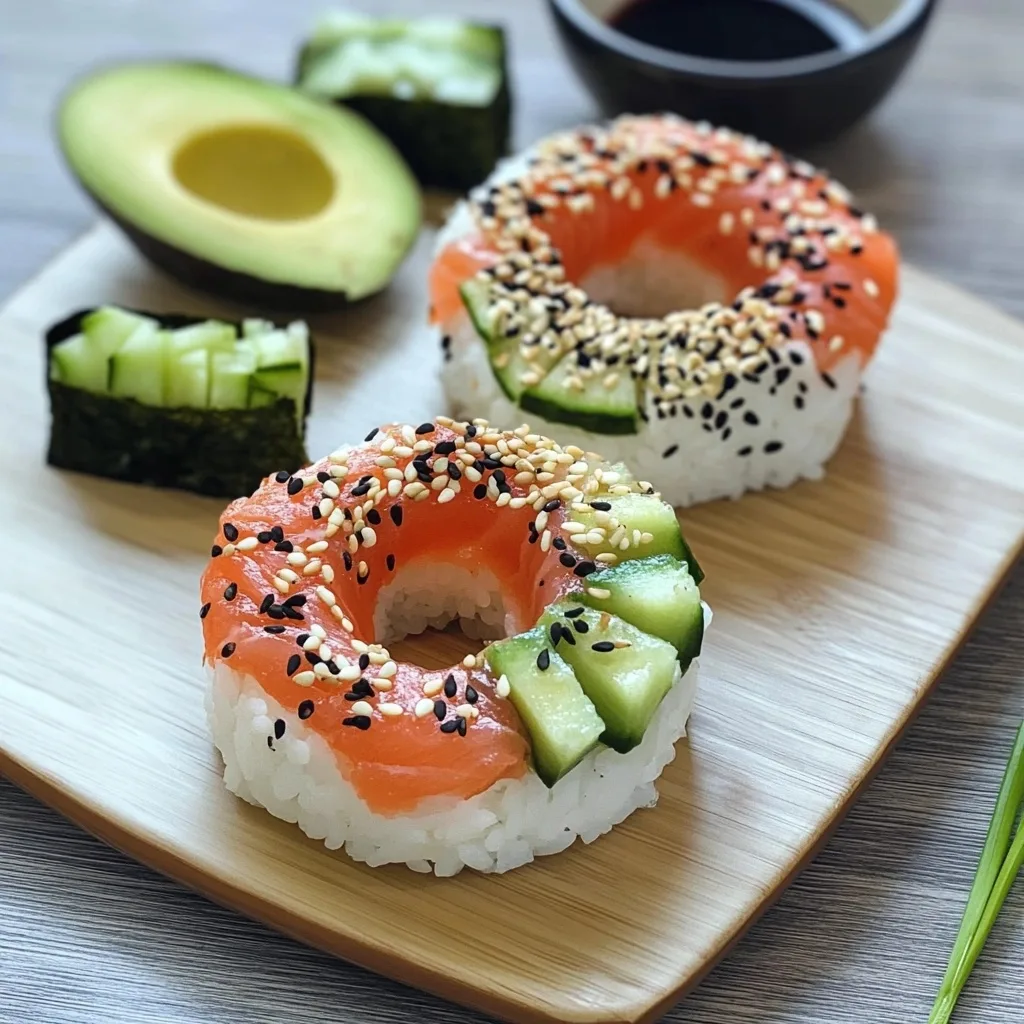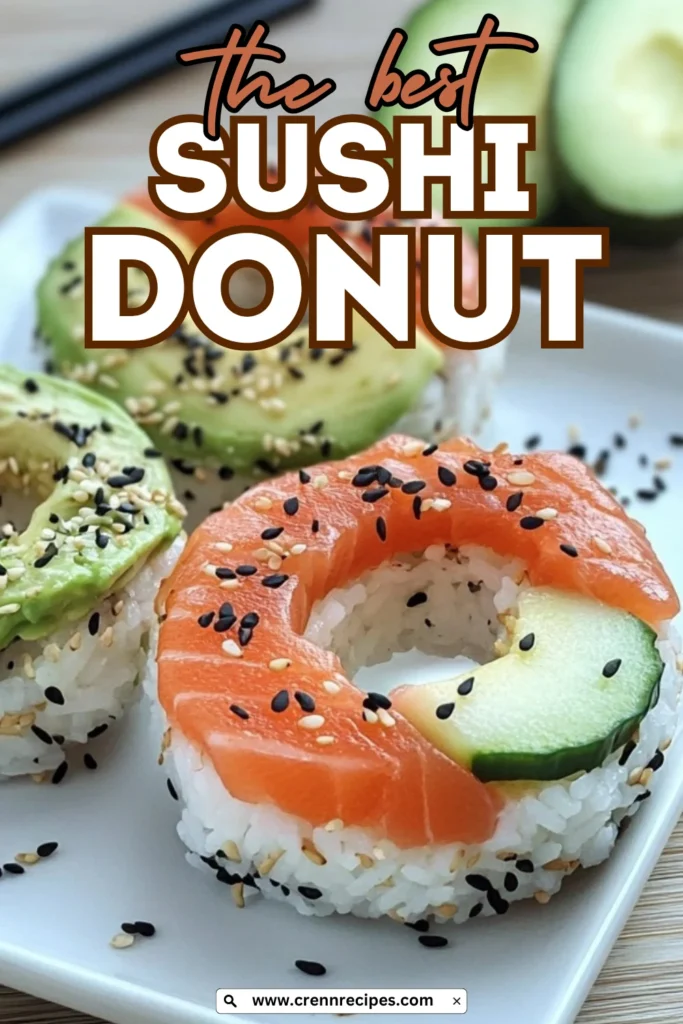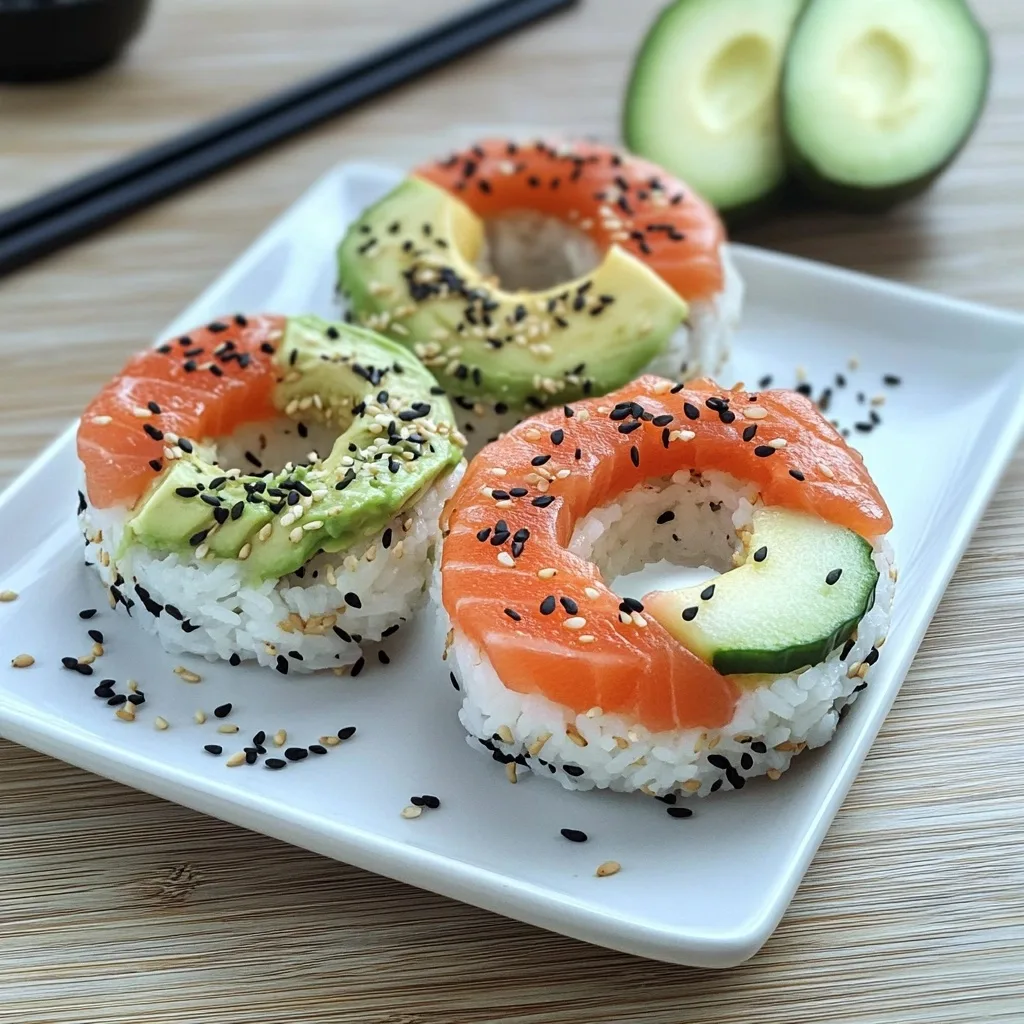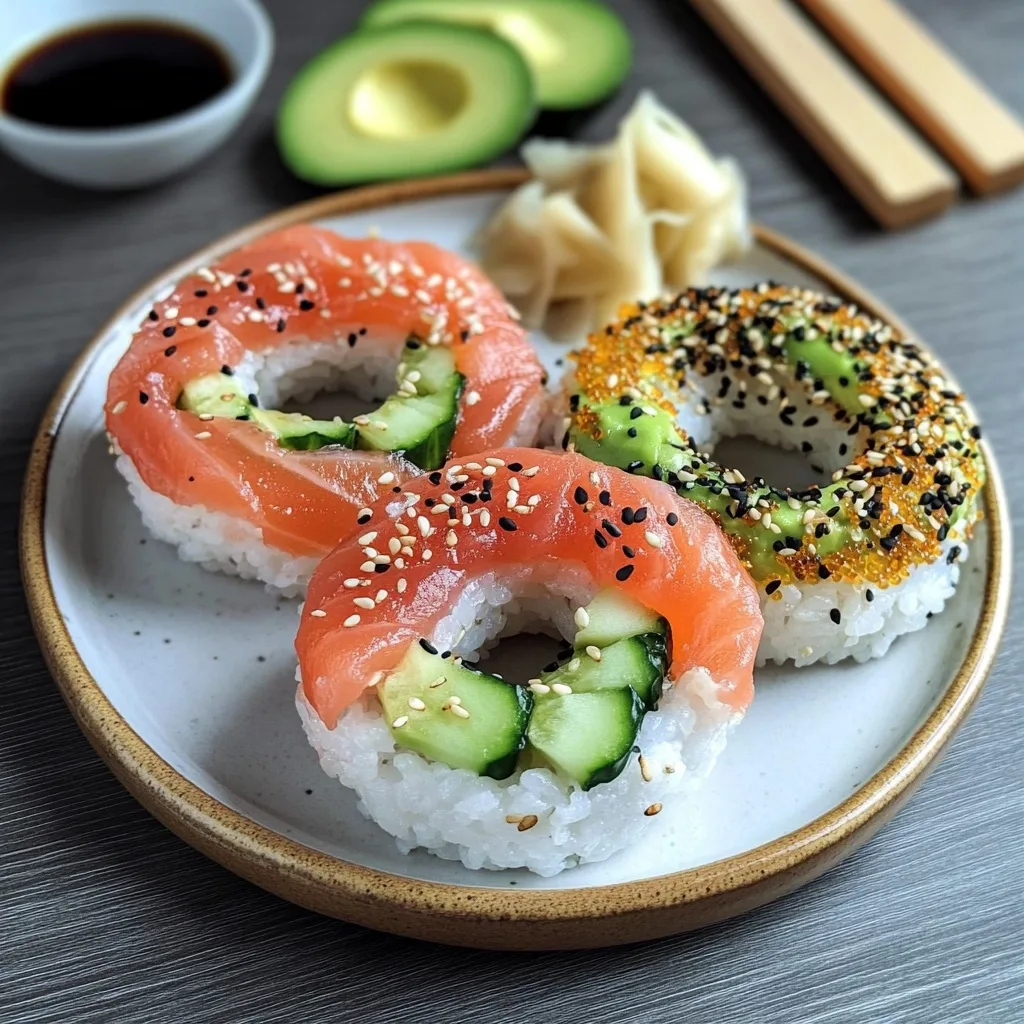Are you looking to impress dinner guests with a creative culinary masterpiece that’s as beautiful as it is delicious? Enter the Sushi Donut – an innovative, Instagram-worthy dish that transforms traditional sushi into a stunning ring-shaped creation. This modern take on Japanese cuisine combines all your favorite sushi elements in a new presentation that’s perfect for special occasions, dinner parties, or anytime you want to elevate your homemade sushi game.
The Sushi Donut isn’t just visually appealing – it’s also incredibly versatile, allowing you to customize the toppings based on your preferences or what’s available at your local market. From vibrant vegetables to premium sashimi-grade fish, these colorful rings offer a delightful mixture of flavors and textures in each bite.
In this comprehensive guide, we’ll walk through everything you need to know to create perfect Sushi Donuts at home, from selecting the right ingredients to mastering the assembly technique. Whether you’re a seasoned sushi maker or a curious beginner, this recipe will help you craft a memorable dish that’s sure to become a new favorite.
What Exactly Is a Sushi Donut?
A Sushi Donut is exactly what it sounds like – sushi ingredients shaped into a donut form. But don’t let the name fool you – there’s no deep frying involved! Instead, seasoned sushi rice is molded into a ring shape, then topped with traditional sushi ingredients like fresh fish, avocado, cucumber, and various garnishes.
This innovative dish maintains all the beloved flavors of traditional sushi while presenting them in a fun, new way. The donut shape creates a perfect canvas for arranging colorful ingredients in visually striking patterns, making each Sushi Donut a miniature work of art. The center hole can be filled with additional ingredients like tobiko (flying fish roe) or small pieces of sashimi, adding both visual interest and a flavor surprise.
The concept originated in social media food trends around 2016 and quickly gained popularity worldwide. Sushi Donuts offer the perfect balance between novelty and tradition – they incorporate classic Japanese flavors and ingredients but with a contemporary presentation that appeals to both the eye and the palate.
Unlike traditional sushi rolls that require special rolling techniques, Sushi Donuts are more approachable for home cooks. The molding process is simpler than precision rolling, making this an excellent entry point for those new to making sushi at home.
Benefits of Making Sushi Donuts at Home
Creating Sushi Donuts in your own kitchen comes with numerous advantages beyond just enjoying a delicious meal. Here’s why you should consider adding this recipe to your culinary repertoire:
Cost-Effective Sushi Experience
Let’s face it – dining at quality sushi restaurants can quickly become expensive, especially for special occasions or larger groups. Making Sushi Donuts at home allows you to enjoy premium ingredients at a fraction of the restaurant price. Even when using high-quality sashimi-grade fish, the overall cost per serving is significantly lower than dining out.
Customization Freedom
When you make Sushi Donuts at home, you have complete control over the ingredients. This means you can:
- Accommodate dietary restrictions and preferences
- Adjust spice levels to suit your taste
- Include only the seafood varieties you enjoy
- Create vegetarian or even vegan versions
- Experiment with unique flavor combinations not available in restaurants
Impressive Entertainment Option
Few homemade dishes have the “wow factor” of beautifully arranged Sushi Donuts. They make an excellent centerpiece for:
- Dinner parties where presentation matters
- Special celebration meals
- Food-focused gatherings
- Date nights at home
- Interactive family cooking sessions
Skill Development
Creating Sushi Donuts helps you develop various culinary skills:
- Proper rice preparation techniques
- Knife skills for precision cutting
- Food styling and plating
- Understanding flavor balancing
- Ingredient quality assessment
The skills you develop while making Sushi Donuts transfer well to other types of cooking, making this recipe an investment in your overall culinary abilities.

Essential Ingredients for Perfect Sushi Donuts
The quality of your Sushi Donuts depends significantly on using the right ingredients. Here’s a detailed look at the key components and what to look for when shopping:
The Rice Foundation
The base of any good Sushi Donut is properly prepared sushi rice. This short-grain Japanese rice has a distinct stickiness that allows it to hold its shape while remaining tender. When shopping for sushi rice:
- Look specifically for rice labeled as “sushi rice” or “short-grain Japanese rice”
- Popular brands include Nishiki, Kokuho Rose, and Tamaki Gold
- Avoid substituting long-grain rice varieties, as they won’t provide the necessary stickiness
- For best results, use rice that’s been harvested within the past year
The seasoning for sushi rice – a mixture of rice vinegar, sugar, and salt – is equally important. Use rice vinegar rather than regular white vinegar for authentic flavor. This seasoned rice mixture (called “sushi-zu”) gives the rice its characteristic tangy-sweet flavor that balances the other ingredients.
Selecting Quality Seafood
For raw fish components in your Sushi Donut, safety and quality are paramount:
- Always purchase seafood labeled specifically as “sashimi-grade” or “sushi-grade” from reputable sources
- Look for fish with firm flesh, clear eyes (if whole), and no strong fishy odor
- Popular options include salmon, tuna, yellowtail (hamachi), and scallops
- If raw fish isn’t available, consider using smoked salmon, poached shrimp, or crab meat as safer alternatives
- When in doubt about freshness, consult with your fishmonger about the best options for raw consumption
Remember that “sushi-grade” isn’t a regulated term but generally indicates fish that has been frozen to kill potential parasites and handled with appropriate care for raw consumption.
Fresh Produce and Garnishes
The vegetables and garnishes add crucial texture, color, and flavor contrasts:
- Avocados should be ripe but firm enough to slice cleanly
- Cucumbers with minimal seeds work best (English or Persian varieties)
- Fresh green onions provide bright color and sharp flavor
- Tobiko (flying fish roe) or masago (capelin roe) add pops of color and texture
- Pickled ginger serves as both garnish and palate cleanser
- Wasabi should ideally be freshly prepared rather than pre-made paste for the best flavor
Nori Selection
The nori (seaweed) component provides structure and the classic sushi flavor:
- Look for sheets that are uniformly dark green and crisp
- Premium grades will be thicker and less likely to become soggy quickly
- Store nori in an airtight container with a desiccant packet to maintain crispness
- Toast nori briefly before using to enhance flavor and texture
Essential Equipment for Sushi Donut Creation
While Sushi Donuts don’t require as many specialized tools as traditional sushi, having the right equipment makes the process much easier:
Donut Molds
You have several options for shaping your Sushi Donuts:
- Silicone donut molds work exceptionally well and make removal easy
- Metal donut pans can be used with plastic wrap to prevent sticking
- Ring molds or cookie cutters with centers can improvise as shapers
- For a completely equipment-free option, you can shape by hand using plastic wrap
Rice Preparation Tools
Proper tools for rice handling include:
- A rice cooker for consistent results (though stovetop preparation works too)
- A wide, shallow wooden bowl (hangiri) or glass bowl for cooling and seasoning rice
- A rice paddle or wooden spoon for mixing seasonings into rice without crushing the grains
- A spray bottle with water to keep hands moist while handling sticky rice
Cutting Tools
Sharp, precise cutting tools are essential:
- A very sharp chef’s knife or santoku knife for vegetable preparation
- A dedicated sashimi knife if you’ll be cutting your own fish (though pre-cut is fine)
- Small specialized scissors for nori cutting and garnish preparation
- A mandoline slicer for achieving uniform, thin vegetable slices
Serving Items
For the full experience, consider these serving elements:
- Flat, minimalist plates in white or black to showcase the colorful donuts
- Small dishes for soy sauce, wasabi, and pickled ginger
- Decorative chopsticks and chopstick rests
- Bamboo serving platters for larger presentations

Step-by-Step Sushi Donut Preparation
Creating perfect Sushi Donuts requires attention to detail, but the process is quite manageable when broken down into steps. Follow this comprehensive guide for foolproof results:
Mastering the Sushi Rice
The foundation of a great Sushi Donut is properly prepared rice:
- Washing the rice: Place 2 cups of sushi rice in a large bowl and cover with cold water. Swish gently with your hands, then drain. Repeat this process 3-4 times until the water runs almost clear. This removes excess starch that would make the rice too gummy.
- Cooking technique: Combine the washed rice with 2¼ cups of water in a medium pot. Bring to a gentle boil over medium heat, then reduce to low, cover, and simmer for exactly 15 minutes without lifting the lid. Remove from heat and let stand, still covered, for another 10 minutes to complete the steaming process.
- Preparing the seasoning: While the rice cooks, whisk together ¼ cup rice vinegar, 2 tablespoons sugar, and 1 teaspoon kosher salt until the sugar completely dissolves. Warming this mixture slightly helps the dissolution process but isn’t strictly necessary.
- Seasoning the rice: Transfer the hot rice to a wide, shallow bowl. Drizzle the vinegar mixture evenly over the rice while using a cutting motion with a rice paddle or wooden spoon to incorporate it. Avoid stirring in circles or pressing down, as this will crush the grains and create a mushy texture. Gentle folding and slicing motions keep the rice grains intact while distributing the seasoning.
- Cooling properly: Fan the rice gently while continuing to fold it occasionally. The goal is to bring it to room temperature or slightly warmer – not cold. The rice should be cool enough to handle but still slightly warm for the best texture and flavor when forming the donuts.
Forming the Perfect Sushi Donut Shape
Creating the distinctive donut shape is easier than it looks:
- Preparing the molds: If using silicone donut molds, lightly spray with cooking oil or water to prevent sticking. If using metal molds, line with plastic wrap first. For the nori bases, use a 3-inch round cutter with a smaller cutter for the center hole to create donut-shaped seaweed pieces.
- Working with wet hands: Keep a small bowl of water nearby and dip your hands frequently to prevent the rice from sticking. Adding a few drops of rice vinegar to this water enhances the effect.
- The packing technique: Take approximately ¼ cup of seasoned rice and gently press it into the donut mold, creating an even layer about ½-inch thick. Ensure the rice is packed firmly enough to hold its shape but not so compressed that it becomes dense and heavy.
- Unmolding: If using a mold, carefully flip it over onto your nori circle and gently press to release the rice. The rice should transfer cleanly to the nori, maintaining its donut shape. If the rice sticks, run a thin knife around the edges to release it.
- Hand-forming alternative: For a mold-free approach, place a piece of plastic wrap on your work surface, add the rice in a ring shape, cover with another piece of plastic wrap, and gently press to form. Remove the top plastic, place the nori on the rice, then flip and remove the remaining plastic.
Artistic Topping Arrangement
The visual appeal of Sushi Donuts comes from thoughtful topping arrangement:
- Creating patterns: Arrange thinly sliced avocado and cucumber in overlapping patterns for visual impact. A spoke pattern radiating from the center creates an attractive design, as does a shingled arrangement around the perimeter.
- Color balance: Consider the color palette of your ingredients when planning your arrangement. Alternate green (avocado, cucumber), pink/red (fish, tobiko), and white/cream (rice, cream cheese) elements for maximum visual contrast.
- Textural variation: Incorporate a mix of smooth elements (avocado, fish), crisp components (cucumber, nori), and pops of texture (tobiko, sesame seeds) for an interesting mouthfeel.
- Height consideration: Build some height with your toppings but avoid making them too tall, which would make eating difficult. Slightly mound ingredients in the center hole for visual interest.
- Final touches: Scatter sliced green onions and a sprinkle of tobiko or sesame seeds as the very last step to add color and texture to the finished presentation.
Serving and Presentation Ideas for Sushi Donuts
The visual presentation of Sushi Donuts is a major part of their appeal. Consider these creative serving suggestions to maximize their impact:
Individual Plating Styles
For an elegant dining experience:
- Place each Sushi Donut on a minimalist square or rectangular plate
- Position small mounds of wasabi and pickled ginger at opposite corners
- Add a tiny dipping bowl of soy sauce
- Garnish the plate with a single edible flower or herb sprig
- Consider a small squeeze bottle of spicy mayo for decorative drizzling
Grazing Board Presentation
For casual gatherings or appetizer presentations:
- Arrange multiple Sushi Donuts on a large wooden board or platter
- Intersperse with small bowls of various dipping sauces and garnishes
- Add complementary items like edamame pods or seaweed salad
- Include decorative chopsticks and small serving spoons
- Label different varieties if you’ve created multiple types
Stacked Display
For a dramatic centerpiece effect:
- Use a tiered serving stand to display Sushi Donuts at different heights
- Place larger, more elaborate donuts on the bottom tier and simpler ones above
- Incorporate small potted herbs or flowers between tiers for natural elements
- Wrap the stand’s posts with thin cucumber ribbons for a cohesive theme
- Use battery-operated tiny lights for evening presentations
Interactive Serving
For a fun, engaging dining experience:
- Create a “build-your-own” Sushi Donut station with rice rings and topping options
- Provide instruction cards for guests new to the concept
- Include a variety of sauces and garnishes for customization
- Supply small plates and serving tools for each guest
- Consider a sake pairing flight to complement the experience
Customization Options and Variations
One of the greatest advantages of Sushi Donuts is their adaptability. Consider these variations to make the recipe your own:
Dietary Adaptations
For specific dietary needs:
- Vegan version: Replace fish with marinated tofu, tempeh, or roasted mushrooms; use vegan cream cheese
- Gluten-free option: Ensure your soy sauce is certified gluten-free (many traditional varieties contain wheat)
- Low-carb adaptation: Use cauliflower rice seasoned with rice vinegar, sugar, and salt as a base instead of sushi rice
- Kid-friendly version: Swap raw fish for cooked options like shrimp, crab sticks, or even teriyaki chicken
Regional Flavor Variations
For interesting cultural fusions:
- Mexican-inspired: Top with mango, avocado, jalapeño, and cilantro; serve with a lime-spiked soy sauce
- Hawaiian poke style: Use marinated tuna, green onion, sesame oil, and crushed macadamia nuts
- Korean influence: Add kimchi, bulgogi beef, and gochujang-based sauce
- Mediterranean twist: Incorporate cucumber, red onion, olives, and feta cheese with a lemon-dill sauce
Seasonal Specialties
For the freshest flavors year-round:
- Spring: Feature cucumber, asparagus tips, and fresh herbs
- Summer: Highlight mango, avocado, and chili flakes
- Fall: Incorporate roasted sweet potato, pomegranate seeds, and maple-infused soy glaze
- Winter: Use citrus segments, crispy fried shallots, and warming spices in the sauces
Texture Enhancements
For interesting mouthfeel variations:
- Add crispy tempura bits or fried garlic chips for crunch
- Incorporate tobiko or masago for delightful pops of texture
- Experiment with microgreens for fresh, delicate elements
- Try quick-pickled vegetables for tangy crunch

Storage and Make-Ahead Tips for Sushi Donuts
While Sushi Donuts are best enjoyed fresh, some components can be prepared in advance:
Rice Preparation
- Sushi rice can be made up to 6 hours ahead and kept at room temperature covered with a damp towel
- Do not refrigerate prepared sushi rice, as it will become hard and lose its desirable texture
- If you must make rice a day ahead, allow it to come fully to room temperature before using
Component Prep
- Cut vegetables and prepare garnishes up to 24 hours ahead and store in airtight containers in the refrigerator
- Slice avocado just before assembly and toss with a bit of lemon juice to prevent browning
- Prepare nori cutouts ahead and store in an airtight container with a desiccant packet to maintain crispness
- Fish should be sliced as close to serving time as possible for optimal freshness and food safety
Limited Storage
If you must store assembled Sushi Donuts:
- They will keep in the refrigerator for up to 2 hours before serving
- Cover very loosely with plastic wrap to prevent drying out but avoid crushing the toppings
- Allow to sit at room temperature for 15 minutes before serving for best flavor
- Do not attempt to store assembled Sushi Donuts overnight, as the quality will significantly deteriorate
Sushi Donut Recipe
Now that we’ve covered the background and techniques, here’s the complete recipe for creating your own beautiful Sushi Donuts at home:
Ingredients
For the rice:
- 2 cups sushi rice, rinsed and drained
- 2¼ cups water
- ¼ cup rice vinegar
- 2 tablespoons granulated sugar
- 1 teaspoon kosher salt
For assembly:
- 6 sheets nori (seaweed), cut into donut-ring–sized circles (use a 3-inch round cutter)
- 1 avocado, thinly sliced
- 1 small cucumber, julienned
- 8 ounces sashimi-grade salmon or tuna, diced
- 4 ounces cream cheese, cut into small cubes
- 2 tablespoons tobiko (flying fish roe) or masago (capelin roe)
- 2 green onions, thinly sliced
- Pickled ginger, for garnish
- Wasabi and soy sauce, for serving
Instructions
Cook the sushi rice:
- In a medium pot, combine your rinsed sushi rice and water. Bring to a gentle boil over medium heat.
- Once it’s bubbling, reduce the heat to low, cover, and let it simmer for 15 minutes without opening the lid.
- Remove from heat and let it steam (still covered) for another 10 minutes.
Season the rice:
- While the rice is resting, whisk together the rice vinegar, sugar, and salt until the sugar is dissolved.
- Transfer the hot rice to a large bowl and gently fold in the vinegar mixture with a wooden spoon or rice paddle, using slicing motions to keep the grains intact.
- Allow the rice to cool until just warm, occasionally folding to help it cool evenly.
Prep the donuts:
- Place your nori circles on a clean counter or cutting board.
- With damp hands, press about ¼ cup of rice onto each ring, forming a neat donut shape.
- Make sure the rice layer is even throughout for the best presentation.
Top them off:
- Layer slices of avocado and cucumber in pretty spoke-like patterns on top of each rice donut.
- Sprinkle the diced salmon (or tuna) in the center hole and around the top.
- Tuck the cream cheese cubes amongst the fish.
- Dot the whole arrangement with a generous spoonful of tobiko.
Finish and serve:
- Garnish with green onions and arrange on a flat dish with pickled ginger on the side.
- Serve with small dishes of soy sauce and wasabi for dipping.
- For an extra kick, drizzle a touch of spicy mayo (mix mayo + Sriracha) over the top before serving.
Troubleshooting Common Sushi Donut Issues
Even experienced cooks might encounter challenges when making Sushi Donuts for the first time. Here are solutions to common problems:
Rice Problems
Issue: Rice is too sticky and difficult to shape
- Solution: Your hands might not be wet enough. Keep a bowl of water with a splash of rice vinegar nearby and dip your hands frequently.
Issue: Rice falls apart when molding
- Solution: The rice might not be properly seasoned or could be undercooked. Ensure the vinegar mixture is thoroughly incorporated and the rice was cooked until tender.
Issue: Rice is mushy instead of distinct grains
- Solution: You may have overworked the rice when mixing in the seasoning. Use gentle cutting motions rather than stirring, and avoid pressing on the rice.
Assembly Challenges
Issue: Toppings slide off the rice
- Solution: Make sure the rice surface is slightly tacky but not wet. Press toppings gently into the rice to help them adhere.
Issue: Donut loses its shape when unmolding
- Solution: The rice might need more time to set. Try chilling the filled mold for 5 minutes before unmolding, or use plastic wrap to help support the shape during transfer.
Issue: Nori becomes soggy quickly
- Solution: Toast the nori briefly before using and assemble the donuts as close to serving time as possible. Keep the bottom of the rice layer as dry as you can.
Ingredient Issues
Issue: Avocado browns quickly
- Solution: Toss sliced avocado with a small amount of lemon or lime juice before arranging on the donut. Assemble as close to serving time as possible.
Issue: Fish doesn’t look fresh by serving time
- Solution: Keep fish refrigerated until the last possible moment before assembly. Consider a quick marinade with a little citrus juice for both flavor and preservation.
Issue: Colors look dull or unappetizing
- Solution: Ensure you’re using the freshest ingredients possible. Enhance colors by adding contrasting garnishes like black sesame seeds, microgreens, or edible flowers.
Sushi Donut FAQs
Q: Can I make Sushi Donuts without raw fish? A: Absolutely! You can substitute cooked seafood like shrimp, crab, or smoked salmon. Vegetarian options include tamago (Japanese omelet), tofu, or additional vegetables.
Q: How far in advance can I make Sushi Donuts for a party? A: For the best quality, assemble Sushi Donuts no more than 1-2 hours before serving. You can prepare all components ahead of time and assemble just before guests arrive.
Q: What’s the best way to eat a Sushi Donut? A: Sushi Donuts can be eaten with chopsticks by breaking off bite-sized pieces. Alternatively, you can slice them into sections like a traditional donut and eat the pieces individually.
Q: Can I use brown rice instead of white sushi rice? A: While traditional sushi uses white short-grain rice, you can experiment with brown sushi rice. Be aware that it has a different texture and may require additional cooking time and slightly more water.
Q: How do I know if fish is safe for raw consumption? A: Purchase fish specifically labeled as “sushi-grade” or “sashimi-grade” from reputable sources. These designations typically mean the fish has been frozen to kill potential parasites and handled appropriately for raw consumption.
More Related Recipes You Might Enjoy
If you’ve enjoyed making this Sushi Donut recipe, you might also like these other creative recipes that feature similar presentation techniques or complementary flavors:
Christmas Maraschino Cherry Shortbread offers another beautiful presentation that’s sure to impress. Like Sushi Donuts, these cookies focus on visual appeal with their striking red and white color contrast, and both recipes benefit from careful arrangement for maximum impact.
For another fresh, vibrant dish perfect for entertaining, try Watermelon Feta Summer Salad. This salad shares the Sushi Donut’s emphasis on fresh ingredients and beautiful color contrasts, making it an excellent pairing for an Asian-inspired summer meal.
And for those special occasions that call for something extraordinary, the High School Graduation Cake provides another opportunity to showcase your food styling skills. Just as the Sushi Donut elevates everyday sushi into something celebration-worthy, this cake transforms a standard dessert into a memorable centerpiece.
Final Thoughts on Sushi Donuts
The Sushi Donut represents the perfect marriage of traditional flavors and modern presentation. By transforming familiar sushi ingredients into an eye-catching ring form, you create a dish that’s not just delicious but also a conversation starter. The beauty of this recipe lies in its adaptability – you can adhere strictly to Japanese tradition or experiment with fusion elements that reflect your personal taste.
Beyond their visual appeal, Sushi Donuts offer a balanced, nutritious meal. The combination of complex carbohydrates from the rice, healthy fats from fish and avocado, and various vitamins and minerals from the fresh vegetables creates a well-rounded dish that’s satisfying without being heavy.
Whether you’re looking to impress guests at your next dinner party, challenge yourself with a new culinary technique, or simply enjoy the meditative process of creating something beautiful, Sushi Donuts offer a rewarding cooking experience. The skills you develop making them – from proper rice preparation to artistic food styling – will serve you well in many other culinary endeavors.
So gather your ingredients, prepare your workspace, and embark on the delightful journey of creating your own Sushi Donuts. With a little practice and creativity, you’ll soon be crafting these edible works of art like a seasoned professional, bringing a touch of culinary magic to your table.
Print
Sushi Donut Recipe: 7 Incredible Ways to Create Beautiful Rings
- Total Time: 55 minutes
- Yield: 6 sushi donuts 1x
- Diet: Low Lactose
Description
A creative twist on traditional sushi, these Sushi Donuts transform seasoned rice into beautiful rings topped with fresh salmon, avocado, cucumber, and sesame seeds. Perfect for entertaining, these visually stunning creations deliver all the classic sushi flavors in an Instagram-worthy presentation that’s surprisingly simple to make at home.
Ingredients
- 2 cups sushi rice, rinsed and drained
- 2¼ cups water
- ¼ cup rice vinegar
- 2 tablespoons granulated sugar
- 1 teaspoon kosher salt
- 6 sheets nori (seaweed), cut into donut-ring–sized circles
- 1 avocado, thinly sliced
- 1 small cucumber, julienned
- 8 ounces sashimi-grade salmon or tuna, diced
- 4 ounces cream cheese, cut into small cubes
- 2 tablespoons tobiko (flying fish roe) or masago (capelin roe)
- 2 green onions, thinly sliced
- Pickled ginger, for garnish
- Wasabi and soy sauce, for serving
Instructions
- Cook the rice: In a medium pot, combine rinsed sushi rice and water. Bring to a gentle boil over medium heat, then reduce heat to low, cover, and simmer for 15 minutes without opening the lid. Remove from heat and let steam (still covered) for another 10 minutes.
- Season the rice: While rice is resting, whisk together rice vinegar, sugar, and salt until sugar dissolves. Transfer hot rice to a large bowl and gently fold in the vinegar mixture using slicing motions to keep grains intact. Let cool until just warm.
- Prep the donuts: Place nori circles on a clean surface. With damp hands, press about ¼ cup of rice onto each ring, forming an even donut shape.
- Top them off: Arrange slices of avocado and cucumber in spoke-like patterns on top of each rice donut. Sprinkle diced salmon in the center hole and around the top. Add cream cheese cubes amongst the fish, then dot with tobiko.
- Finish and serve: Garnish with green onions and arrange on a flat dish with pickled ginger. Serve with soy sauce and wasabi for dipping. Optionally, drizzle with spicy mayo (mixture of mayonnaise and Sriracha) for extra flavor.
Notes
- For best results, keep your hands damp when handling the rice to prevent sticking.
- Sushi-grade fish is essential for food safety when serving raw. If unavailable, substitute with smoked salmon or cooked seafood.
- Silicone donut molds make shaping easier, but you can also form the donuts by hand using plastic wrap.
- These are best enjoyed immediately after preparation, as rice will harden when refrigerated.
- For a vegetarian version, replace fish with extra avocado, mango, or tamago (Japanese omelet).
- Prep Time: 30 minutes
- Cook Time: 25 minutes
- Category: Appetizer, Main Course
- Method: No-Cook
- Cuisine: Japanese, Fusion
Nutrition
- Serving Size: 1 sushi donut
- Calories: 285
- Sugar: 3g
- Sodium: 450mg
- Fat: 12g
- Saturated Fat: 5g
- Unsaturated Fat: 6g
- Trans Fat: 0g
- Carbohydrates: 35g
- Fiber: 2g
- Protein: 10g
- Cholesterol: 40mg

